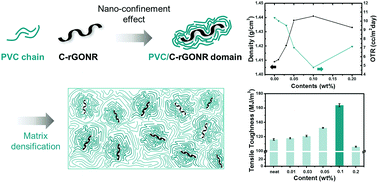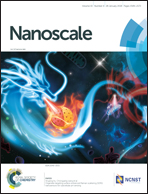Nanoconfinement effects of chemically reduced graphene oxide nanoribbons on poly(vinyl chloride)†
Abstract
Polymeric nanocomposites with graphene-based nanocarbons (GNCs) have been extensively studied with emphasis on the percolation of nanofillers toward electrical, rheological, and mechanical reinforcement. In this study, we report an unusual indirect reinforcing phenomenon of highly defective GNCs dispersed in the poly(vinyl chloride) (PVC) matrix via densification of the polymer packing originating from nanoscale confinement. Herein, chemically reduced graphene oxide nanoribbons (C-rGONRs) are employed as a nanofiller. The inclusion of defective and oxygen-functionalized C-rGONRs resulted in a dramatic densification of the PVC host with extremely low C-rGONR loading, largely exceeding the theoretical calculation from a rule of mixture. Along with the densification, the glass transition temperature of PVC also increased by 28.6 °C at 0.1 wt% filler loading. Remarkably, the oxygen barrier property and mechanical toughness under tension for the PVC/C-rGONR nanocomposite were the maximum when the greatest densification occurred. The structure–property relationship of the nanocomposites has been discussed with an emphasis on the nanoscale confinement phenomenon.



 Please wait while we load your content...
Please wait while we load your content...